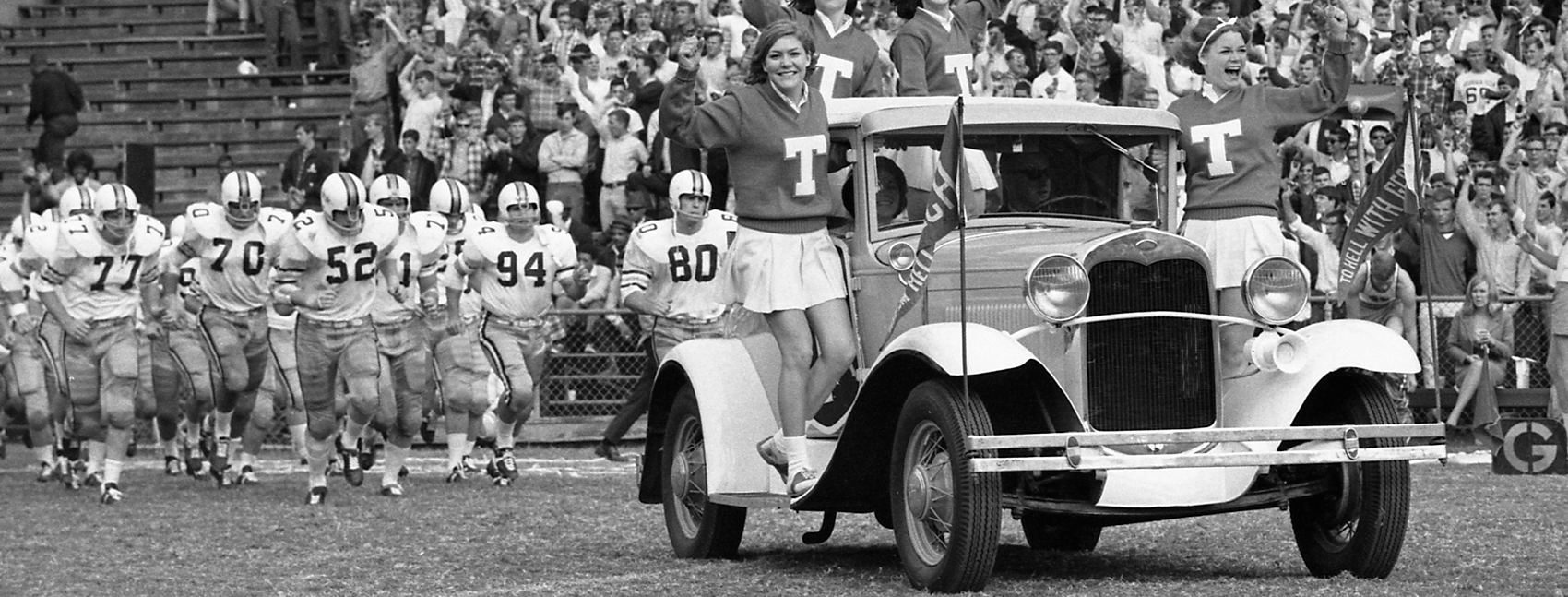“(I’m a) Ramblin’ Wreck from Georgia Tech” is among a handful of the most well known fight songs in the country, and its lyrics are uniquely its own. But it’s had to wrest the title from other schools who have used versions of the song for their own teams. The original composition upon which “Ramblin’ Wreck” is based, “Son of a Gambolier,” was a drinking song composed in the late 1800s. (A gambolier, by the way, is someone who likes to have a good time, often irresponsibly.) The tune was adapted as a fight song by Dickinson College, South Dakota School of Mines and Technology, Colorado School of Mines, Ohio State University and Rensselaer Polytechnic. Not all continue to use the melody today—and none have gone on to reach the legendary status of Tech’s song. While fight songs aren’t typically known for their modesty or civility, various lyrics have caused agitation for more than a century: In the 1908 Blueprint, the words “hell” and “helluva” were expunged for being “too hot to print.”
For now, the lyrics have remained—and the world still loves the tune. In 2017, USA Today named it one of the 10 best fight songs in college football. UGA’s (obviously) didn’t make the cut.
Lyrics
Ramblin’ Wreck
I’m a Ramblin’ Wreck from Georgia Tech and a hell of an engineer
A helluva’, helluva helluva helluva helluva engineer
Like all the jolly good fellows I drink my whiskey clear
I’m a Ramblin’ Wreck from Georgia Tech and a hell of an engineer
Oh, if I had a daughter sir, I’d dress her in white and gold
And put her on the campus, sir, to cheer on the brave and bold
And if I had a son, sir, I’d tell you what he’d do
He would yell “To Hell With georgia” like his daddy used to do
Oh, I wish I had a barrel of rum and sugar three thousand pounds
A college bell to put it in and a clapper to stir it around
I’d drink to all the good fellows who come from far and near
I’m a ramblin’ gamblin’ hell of an engineer! Hey!
Alma Mater
Oh sons of Tech arise behold
The banner as it reigns supreme
For from on high the White and Gold
Waves in its triumphant gleam,
The spirit of the cheering Throng
Resounds with joy revealing
A brotherhood in praise and song
In memory of the days gone by
Oh, Scion of the Southland
In our hearts you shall forever fly!
We cherish thoughts so dear for three
Oh Alma Mater in our pray’r
We plead for you in victory
And in the victory we share,
But when the battle seems in vain
Our spirit never falters
We’re ever one in joy and pain
And our union is a lasting bond;
Oh may we be united
Till the victory of life is won!
Up With The White and Gold
Up with the white and gold
Down with the red and black
Georgia Tech is out for a victory
Well drop a battle axe on georgia’s head
When we meet her our team is sure to beat her
Down on the old farm there will be no sound
‘Till our bow wows rips through the air
When the battle is over georgia’s team will be found
With the Yellow Jacket’s swarming ‘round! Hey!
Facts about the fight song:
- First appeared in print in the 1908 year book, The Blue Print, under the title "What Makes Whitlock Blush."
- The melody's origins have been credited to different sources. One is a marching song of a regiment of Scotsmen called “The Son of a Gambolier."
- Another is attributed to one Harry McCarthy, a variety entertainer, who is said to have written it as a marching song, "The Bonnie Blue Flag", in the spring of 1861. In his lyric he recounts the reasons why the South seceded from the Union. It became popular in the South with 11 editions, each with slightly different words, printed by the war's end.
- In 1879, The Colorado School of Mining, began using a version of the song for its fight song, calling it “The Mining Engineer”
- The first arrangement of the song as "The Ramblin' Wreck" at Georgia Tech is attributed to Mike Greenblatt, the first official band leader, at Tech, in 1910.
- In 1914, Tech band leader, Frank Roman, created another arrangement which he copyrighted. The song became popular with big name bands and was often played on the radio becoming popular nationwide. When Roman died in 1928, his widow sold his music to the Melrose Bros. Music Company, including Tech's famous song.
- The copyright expired in 1952 and Greenblatt rewrote the old arrangement and applied for a new copyright. In 1953, Mr. Greenblatt signed over his rights of that arrangement to the Institute for one dollar.
- The song made news again in later years when Paul McCartney bought the Melrose portfolio but the matter was quickly cleared up legally and Tech has its song forever.
- Frank Roman wrote and Arranged “Up With the White and Gold” in the 1920s to commemorate the colors.
- Frank Roman wrote the music for the Alma Mater and words were done by I. Granath, ARCH 1923.
The Song That Drives Tech Football
By Pete Croatto
“I’m a Ramblin’ Wreck from Georgia Tech,” the fight song has declared since 1905. The song hits differently if you’re on the football team.
It nestles into the soul, turning three verses and 148 words into a spiritual experience. As star running back Jamal Haynes says, Georgia Tech football without “Ramblin’ Wreck” would “feel almost abnormal.”
The song has a firm place in Tech football lore: It is sung after every win. But it’s an emotional ballast for the team in good times and bad.
Haynes was a redshirt freshman in 2022, when the Yellow Jackets lost a winnable game in the middle of a 5-7 season. He remembers singing “Ramblin’ Wreck” huddled with his teammates and, amidst the gloom, feeling its impact.
“A lot of the times when I sing the song, I kind of get chills,” Haynes says. “It feels like you’re surrounded by family. Especially after a game where people might be injured. It brings everything into perspective. It really reunites us as a Georgia Tech family.”
That includes the fans. Haynes and ace linebacker Kyle Efford both associate “Ramblin’ Wreck” with beating the then-undefeated University of Miami last season, which prompted fans to flood the field while the song provided a soundtrack for their jubilance.
Singing “Ramblin’ Wreck” with the crowd after a win is a communal experience, Efford says. “We’re all here, we’re all together, we’re all family,” he explains. “We all want the same common goal. Not a lot of people get to experience that—just to have a crowd that is in tune with you. It changes your whole perspective on the game and gives you much more to play for,” he says.
For Efford, singing the fight song loud and proud is also a chance to release the emotions that come with 60 minutes of focus and intensity. After a win, “it’s a natural high,” he says.
The song also serves as a rite of initiation. First-year players are expected to learn it before the season starts. (Georgia Tech’s band visits the practice field during training camp to teach the song.) Efford and Haynes say it’s taken seriously. If you can’t be bothered to learn this tradition, which is important to this team, how can I trust you on the field?
“Ramblin’ Wreck” is easy to learn but tricky to sing. Employing a mix of tenor and baritone helps, says head football Coach Brent Key, Mgt 01. There are parts that get “a little screwy,” including the string of four “helluva”s in the second line of the first verse.
“I think the song is perfect,” Haynes adds. “I feel like it’s a good representation of the past of Georgia Tech, the present of Georgia Tech, and the future that it holds.” Haynes’ only complaint: He would like more slamming of UGA.
Key was a four-year starter at guard for Georgia Tech. “Ramblin’ Wreck” is “probably instilled in him,” Efford says. He’s right: Whether Key leads the sing-along or serves in the sweaty, battered chorus, he has drunk to all the good fellows who come from far and near.
“From the very first time I sang it, I embraced it,” Key says. That was despite growing up in Birmingham, Alabama, rooting for the Crimson Tide and banishing “the Yellow Jackets to a watery grave.” When Key came to Tech, he started yelling for engineers and cursing Georgia. He’s looking forward to one day teaching his daughter, Harper, age 6, the tradition. She doesn’t know the song, yet. “I don’t want her saying ‘helluva’ that much,” Key says. Another tradition he wants to bring to Tech is to win, which will provide even more opportunities for everyone to cheer on the brave
and bold. “It’s all full circle,” Key says.
Check out the Georgia Tech Glee Club singing the Fight Song on the Ed Sullivan Show!
A Band that Marches to its Own Beat
By Jon Ross
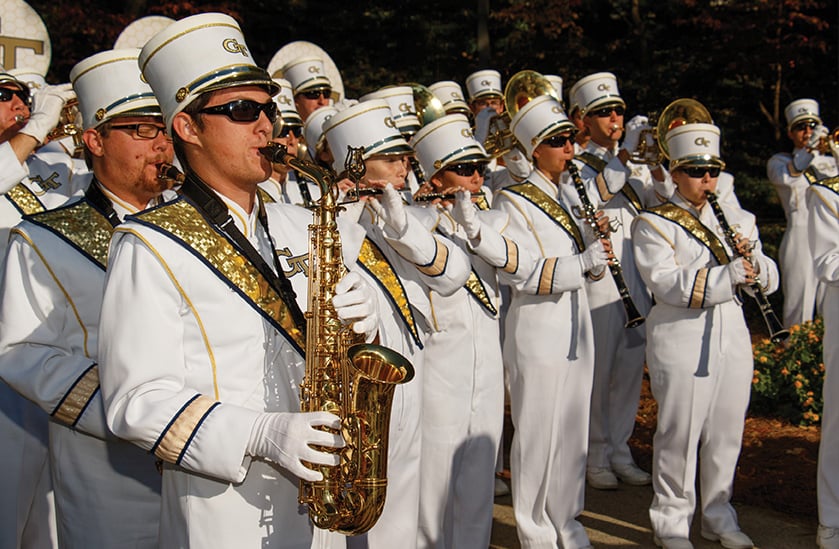
Building a strong marching-band foundation before students start juggling practice with Tech’s infamously difficult coursework is extremely important, Andrews says. The grueling schedule also prepares new marchers for the lengthy football season, in which game days—both at home and on the road—are usually weekend-consuming marching band affairs. “I just tell any group projects in advance that they’re not going to hear from me at all on Saturdays,” Andrews says. “My weekends are entirely for football.”
Andrews is just one semester away from a bachelor’s degree in aerospace engineering, and she credits the marching band with helping her create a healthy work-life balance. She looks at serving as a drum major in the band as a creative outlet that reduces stress built up during the week.
Passion for the Music and the Institute
During the game, musicians are nearly always playing music. Moore is quick to point out that on-field marching during pre-game and half-time only accounts for around 17 minutes of a six-hour day of music making, so musicality and endurance are equally important elements.
The full Yellow Jacket Marching Band breaks up into smaller units to cover different sporting events during the academic year. Concurrent with football season, smaller pep bands play at volleyball games, while the spring semester is mainly reserved for basketball.
Student musicians travel with those teams as well. In particular, Moore will never forget conducting a cohort of band members in San Antonio on April 5, 2004, as the Tech men’s basketball team challenged the University of Connecticut for the NCAA Championship. “It’s one of the biggest stages we can have as a band and as fans,” he says.
Moore adds that while such trips are fun and are unique experiences for the students, the marching band, in all its myriad forms, represents the Institute as a whole.
Likewise, the band is populated by a cross-section of the Tech student body who are committed to its mission, despite the demands of Tech’s challenging academic programs. Since membership is strictly voluntary, Moore says his musicians are some of the most dedicated and passionate Yellow Jackets on campus. “They’re in marching band because they love to play music and because they love Tech,” Moore says. “A lot of them come to us to feel a little bit of peace at the end of a long day of coursework.”
Moore knows that to keep the band operating at the highest level, he must continue to engage sports and music fans alike. In recent years, he’s experimented with adding more technology into his football halftime shows. And during basketball season, he’s even encouraged the crowd to vote online just how fast and loud the band plays certain songs. Bringing the audience into the band experience is one way to keep things fresh, he says.
“We’re not in a competitive environment like high school bands are, but we’re constantly striving to keep the music challenging and the movement interesting,” he says. “We’re a traditional college marching band but also one that tries to stay current, contemporary and looking down the road into the future.”
Humble Beginnings
The Georgia Tech Marching Band started almost on a whim with students who were simply looking for a musical outlet. In 1908, a small group of 14 Tech musicians got together to play school songs and support the football team. What began as an ensemble dedicated to informal music-making has since evolved into a band embedded into the fabric of the Institute.
The band existed without a director for a couple of years, until the students convinced leader Mike Greenblatt to come on board officially, albeit only on a part-time basis. (The direction of the band remained a part-time gig for nearly 70 years.) Greenblatt is most famous for writing the first arrangement of Tech’s legendary fight song, “Ramblin’ Wreck,” in 1910.
In 1914, Frank “Wop” Roman became the next to oversee the band and remained at the helm until his death in 1928. Under Roman’s tenure as director, the Georgia Tech Band Club was formed, and the Iota chapter of Kappa Kappa Psi, a national honorary band fraternity, was founded. Roman is credited with having arranged and copyrighted a revised version of the “Ramblin’ Wreck,” as well as “Up with the White and Gold” and the Georgia Tech “Alma Mater” which are still performed today. (Roman is also credited as the composer of the “Alma Mater.”) Roman’s Tech Band became the first band to broadcast live dance music over the radio, playing a dance concert on campus that was transmitted via wireless radio to the Capital City Club in Atlanta.
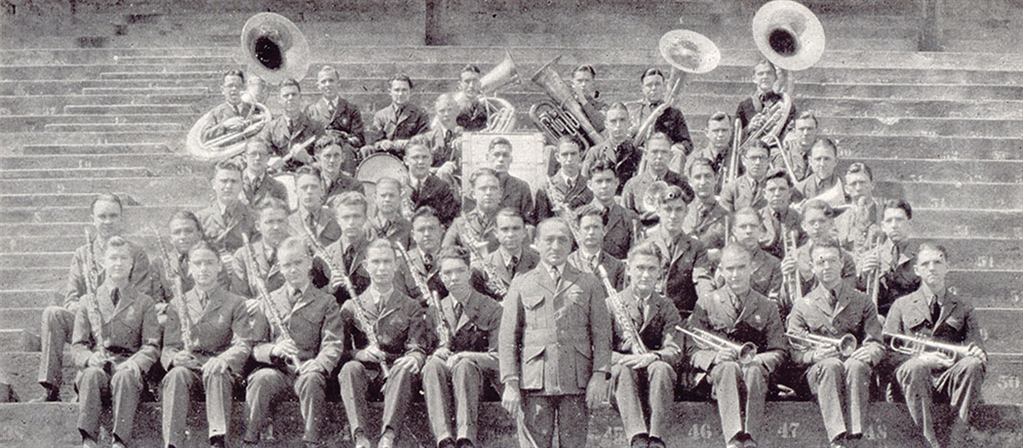
The Georgia Tech band grew and changed over the decades, and included the development of a traditional marching band, as well as an orchestra, symphonic band, dance music ensembles, pep bands and other iterations.
When Tom Billings, CE 74, joined the Yellow Jacket Marching Band as a freshman in the early 1960s, member-ship had ballooned to 100. Billings had played clarinet in his high school band and wanted to continue honing his chops at the college level. For him, the marching band also served as a release from his daily class load.
“I was apprehensive about joining the band because Tech’s a hard place, and I worried about if I would have enough time to do the band and my studies as well,” says Billings, who served for years as the band’s official photographer and videographer. “But I realized that I needed an outlet, so I wasn’t just studying all the time.”
Billings was among the students who journeyed to the Sun Bowl in 1970—a memory that still stands out in his mind. His experience with the band so enhanced his college career that Billings helped found the band’s alumni association in 1979, serving as its first leader and rallying band alumni to help fund band trips. For instance, the group raised $10,000 to help the marching band travel to Ireland in 2016 for the Aer Lingus College Football Classic.
His position with the band has allowed Billings to study the group’s progression from casual gathering to world-class ensemble. “The band’s prestige has certainly in-creased over the years,” he says. “For a school that has never had any traditional music majors, I think the Tech band has done amazingly well.”
Sound Direction
Christopher Moore has been involved with the Georgia Tech Marching Band since 1995, first serving under James “Bucky” Johnson, the band’s first full-time director, who retired in 2001. During Moore’s time leading the Tech band, he’s seen the group’s membership and prestige swell. In 2016, he led a record group of 370 musicians with a staff of assistant directors, student drum majors and assorted student support personnel.
The Georgia Tech Marching Band has become the soundtrack to Tech football, and its omnipresence at games is glaringly apparent only when the band is absent. But thankfully, Moore can only recall one time when the band failed to travel to a football away game. The economic collapse was in full swing, and at the time, administrators had made the tough decision to leave the band at home.
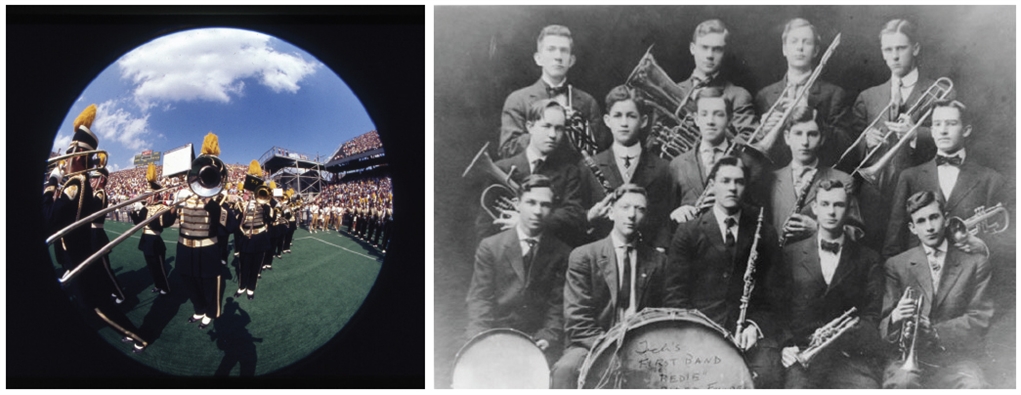
It turns out that forgetting the band was a bad idea.
“The very next week, the coach was like, ‘Nope. We’re never going to do that again,’” Moore says. “When the football team runs out on the field, they expect to hear the fight song.”
A collegiality with the Athletics Association and Georgia Tech’s sports teams is important, Moore says, and he’s worked hard to nurture this symbiotic relationship. Moore will occasionally invite various coaches to talk with his musicians, and he says the entire athletics operation is enthusiastic about the marching band and what it brings to the college sports experience for players and fans alike.
To freshman band members, Moore emphasizes that fostering school pride is the band’s driving focus. Many of his marchers were involved with competitive units in high school, and he wants them to bring their competitive spirit wherever they march and play. “Our No. 1 job is to inspire the fans and support the team,” he says.
On football game days at Tech, the band congregates three hours before kickoff, playing in various small ensembles throughout campus to get students excited about the game. This culminates with a final mini pep rally featuring the entire band. “We pied-piper the fans into the stadium,” Moore says.
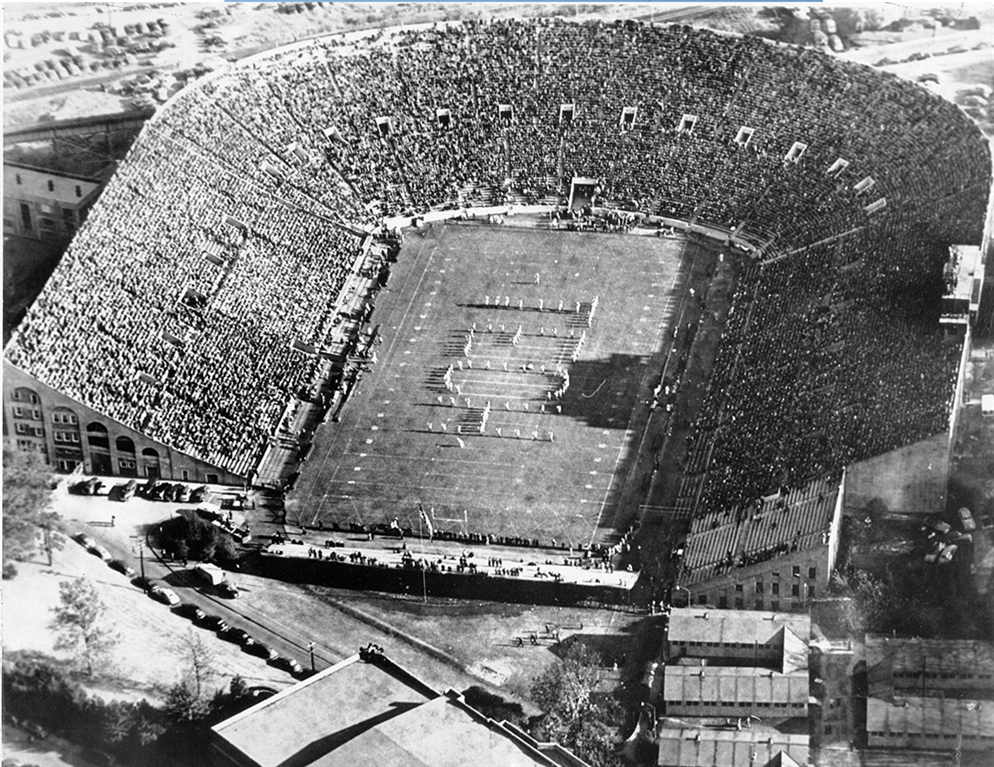
During half-time shows, you’ll find her perched atop an aluminum ladder on the side of the field, mirroring director Christopher Moore’s hand motions as she marks tempo, leading the band through their paces.
During the game, the marching band huddles on bleachers in the stands, a sea of white uniforms accent-ed by shimmery bands of gold. As a unit, the band writhes and shakes with an unabashed intensity, working the surrounding crowd into a frenzy with their infectious energy and unmistakable sound. These student musicians are having a good time, and this liveliness translates to the crowd.
“We’re with all of our friends, we’re playing music, we’re at the football games—it’s absolutely a blast,” Andrews says.
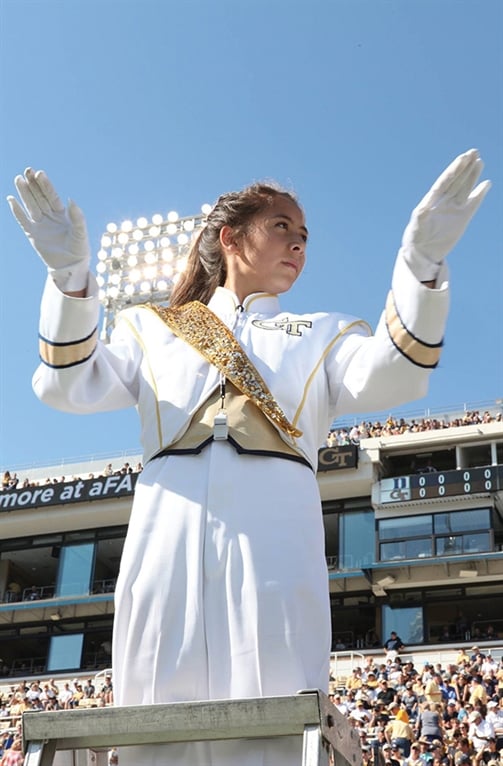 In the middle of August, a full week before most Georgia Tech students arrived on campus, Georgia Tech Yellow Jacket Marching Band drum major Dawn Andrews walked up the steps of the Couch Building for the first work-out of the school year.
In the middle of August, a full week before most Georgia Tech students arrived on campus, Georgia Tech Yellow Jacket Marching Band drum major Dawn Andrews walked up the steps of the Couch Building for the first work-out of the school year.
Andrews spent the next five days as one of 340 student members learning new music, honing marching motions and committing half-time shows to muscle memory from 9 a.m. to noon, 3 p.m. to 5 p.m., and again from 7 p.m. to 10 p.m. Practicing non-stop for an entire week marks the start of the season for the marching band. The rigor of this presemester band camp is some-thing this veteran marcher knows well, but she also relishes it as a time to bond with her fellow Yellow Jackets.
“I love the way that marching band gives us all a chance to build a community before school starts,” Andrews says. “The band really gets a chance to know each other and find their way around campus.”
She admits that while the intensity of band camp can be a little daunting, once classes begin, the frenzied pace relaxes, if only a little bit. During the fall semester, members practice together for two hours three times a week, gaining elective credit for their effort.
